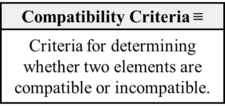Difference between revisions of "Compatibility Criteria (Fraser-Sarwar-2018)"
Ameer Sarwar (talk | contribs) |
|||
| Line 6: | Line 6: | ||
|Authors List=Ameer Sarwar, Patrick Fraser | |Authors List=Ameer Sarwar, Patrick Fraser | ||
|Formulated Year=2018 | |Formulated Year=2018 | ||
| − | |Description= | + | |Description=Like the demarcation and acceptance critera, the compatibility criteria are part of an epistemic community's employed method of the time. The community uses this criteria to determine whether two elements -- methods, theories, or questions -- are mutually compatible. This criteira can be used to determine the compatibility of elements present in the mosaic, as well as those outside of it. Indeed, scientists often think about whether a proposed theory is compatible with the theories actually accepted at the time. |
| + | |||
| + | Moreover, the compatibility criteria is strictly between two elements, i.e., it tells the community whether any pair of elements is compatible. However, if element A is compatible with B, and B is compatible with C, then by transitivity A is compatible with C. As a result, a mosaic is a set of mutually compatible elements. In this way, the compatibility of the mosaic of a given community can be understood in terms of the compatibility of its constituent elements. | ||
|Resource=Fraser and Sarwar (2018) | |Resource=Fraser and Sarwar (2018) | ||
|Prehistory= | |Prehistory= | ||
Revision as of 18:45, 11 October 2020
This is a definition of Compatibility Criteria that states "Criteria for determining whether two elements are compatible or incompatible."
This definition of Compatibility Criteria was formulated by Patrick Fraser and Ameer Sarwar in 2018.1 It is currently accepted by Scientonomy community as the best available definition of the term.
Contents
Scientonomic History
Acceptance Record
| Community | Accepted From | Acceptance Indicators | Still Accepted | Accepted Until | Rejection Indicators |
|---|---|---|---|---|---|
| Scientonomy | 11 October 2020 | The definition became accepted as a result of the acceptance of the respective suggested modification. | Yes |
Suggestions To Accept
Here are all the modifications where the acceptance of this definition has been suggested:
| Modification | Community | Date Suggested | Summary | Verdict | Verdict Rationale | Date Assessed |
|---|---|---|---|---|---|---|
| Sciento-2018-0017 | Scientonomy | 28 December 2018 | Accept the new definition of compatibility criteria as criteria for determining whether two elements are compatible or incompatible. | Accepted | The discussions concerning this modification took place mostly online, but primarily outside of this encyclopedia. There is a communal agreement that the modification is to be accepted as it fixes "an obvious drawback of [Barseghyan's] original definition".c1 Since "compatibility is a stance that can be taken towards methods, theories, and questions alike"c2 it is agreed that we need a definition that is applicable to all epistemic elements, not merely theories. It was also noted that the new definition has the advantage of being "neutral to the the addition of new epistemic elements to the scientonomic ontology".c3 | 11 October 2020 |
Question Answered
Compatibility Criteria (Fraser-Sarwar-2018) is an attempt to answer the following question: What is compatibility criteria? How should it be defined?
See Compatibility Criteria for more details.
Description
Like the demarcation and acceptance critera, the compatibility criteria are part of an epistemic community's employed method of the time. The community uses this criteria to determine whether two elements -- methods, theories, or questions -- are mutually compatible. This criteira can be used to determine the compatibility of elements present in the mosaic, as well as those outside of it. Indeed, scientists often think about whether a proposed theory is compatible with the theories actually accepted at the time.
Moreover, the compatibility criteria is strictly between two elements, i.e., it tells the community whether any pair of elements is compatible. However, if element A is compatible with B, and B is compatible with C, then by transitivity A is compatible with C. As a result, a mosaic is a set of mutually compatible elements. In this way, the compatibility of the mosaic of a given community can be understood in terms of the compatibility of its constituent elements.
Reasons
No reasons are indicated for this definition.
If a reason supporting this definition is missing, please add it here.
Questions About This Definition
There are no higher-order questions concerning this definition.
If a question about this definition is missing, please add it here.
References
- ^ Fraser, Patrick and Sarwar, Ameer. (2018) A Compatibility Law and the Classification of Theory Change. Scientonomy 2, 67-82. Retrieved from https://scientojournal.com/index.php/scientonomy/article/view/31278.
